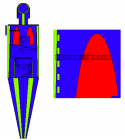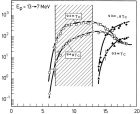Abstract
Research Article
Glycemic status and its effect in Neonatal Sepsis - A prospective study in a Tertiary Care Hospital in Nepal
Badri Kumar Gupta*, Binod Kumar Gupta, Amit Kumar Shrivastava and Pradeep Chetri
Published: 27 September, 2019 | Volume 2 - Issue 1 | Pages: 015-019
Introduction: Sepsis is an important cause of morbidity and mortality among neonates. Neonatal sepsis can alter the glucose level and both hypoglycemia and hyperglycemia may occur. A high or low blood glucose level may have a significant effect on the outcomes in patients of neonatal sepsis.
Aims: The aim of the study to see the glycaemic status and its effect on outcome of neonatal sepsis.
Material and Methods: This hospital based prospective observational cross-sectional study was conducted in Neonatal Intensive Care Unit in Universal College of Medical Sciences, a tertiary care hospital over a period of 4 months, from May 2019 to August 2019. A total of 220 Neonates suspected sepsis under the age of 28 days admitted in NICU, were studied and included in our study. Clinically suspected neonatal sepsis cases were enrolled in the study. Venous blood was collected before giving any intravenous fluid, dextrose or antibiotics and blood sugar, complete blood counts, CRP levels and blood culture were send to laboratory within half hour of collection. All patients included in this study were treated accordingly and followed up strictly. Blood glucose level and mortality of neonates having hypoglycemia, hyperglycemia were analyzed among CRP and culture positive patients. Quantitative data were expressed as mean and standard deviation. Qualitative data were expressed as frequency and percentage and comparison carried by Chi-square (χ2) test.
Results: A total of 220 patients clinically diagnosed as neonatal sepsis were studied. 118 (53.6%) patients were found CRP positive and 56 (25.5%) patients were blood culture positive. Glycaemic status was analyzed among CRP and culture positive patients. Majority (55.9%) patients were found normoglycemic, 35.5% were found hypoglycemic and 8.6% were found hyperglycaemic in this study. 182 (82.73%) patients were cured and 38 (17.27%) died. Mortality was high in hypoglycaemic patients (34.4%) compared with normoglycaemic patients (9.82%), but the difference was not statistically significant (p > 0.05) between two groups, the mortality was high in hyperglycaemic patients (58.33%) compared with normoglycaemic patients (9.82%) and the difference was statistically significant (p < 0.05) between two groups.
Conclusion: Alteration of glycaemic status occurred in septic newborn. Mortality is higher among the septic newborn with hyperglycemia. The present study found that majority of neonate with sepsis had high mortality rate when blood glucose level were either more than 145 mg/dl or less than 45 mg/dl. This signifies the importance of meticulous blood glucose estimation in cases of neonatal sepsis to improve mortality outcome.
Read Full Article HTML DOI: 10.29328/journal.japch.1001006 Cite this Article Read Full Article PDF
Keywords:
Glycemic status; Neonatal sepsis; Outcome; Antibiotic
References
- Fuchs A, Bielicki J, Mathur S, Sharland M, Anker JNV, et al. Antibiotic Use for Sepsis in Neonates and Children. 2016.
- Chapagain RH, Acharya R, Shrestha N, Giri BR, Bagale B, et al. Bacteriological Profile of Neonatal Sepsis in Neonatal Intermediate Care Unit of Central Paediatric Referral Hospital in Nepal. J Nepal Health Res Counc. 2015; 13: 205-208. PubMed: https://www.ncbi.nlm.nih.gov/pubmed/27005713
- Do HS. Government of Nepal Ministry of health and population. Annual report Kathmandu government of Nepal ministry of health and population department of health services.
- Ahmad S, Khalid R. Blood glucose levels in neonatal sepsis and probable sepsis and its association with mortality. J Coll Physicians Surg Pak. 2012; 22: 15-18. PubMed: https://www.ncbi.nlm.nih.gov/pubmed/22237183
- Stoll BJ, Shane AL. Infection of the neonatal infant. In: Behrman RE; Kliegman RM, Stanton BF, III JWSG, Schor NF, Behrman RE, editors. Nelson textbook of pediatrics. Philadelphia: Elseveir Saunders. 2015; 909-925.
- Government of the People’s Republic of Bangladesh. Students’ Handbook on Integrated Management of Childhood Illness. Dhaka. 2011.
- Hoseth E, Joergensen A, Ebbesen F, Moeller M. Blood Glucose Levels in a Population of Healthy, Breast Fed, term Infants of Appropriate Size for Gestational Age. Arch Dis Child Fetal Neonatal Ed. 2000; 83: 117-119. PubMed: https://www.ncbi.nlm.nih.gov/pubmed/10952705
- Jain A, Aggarwal R, Jeeva Sankar M, Agarwal R, Deorari AK, et al. Hypoglycemiain the newborn. Indian J Pediatr. 2010; 77: 1137-1142.
- Wilker RE. Hypoglycemia and Hyperglycemia. In: Cloherty JP, Eichenwald EC, Stark AR, editors. Manual of Neonatal Care. 6th ed. Philadelphia: Lippincott Williams and Wilkins. 2008; 540-549.
- Najati N, Sabotakin L. Prevelance and underlying etiologies of neonatal hypoglycemia. Pak J Biol Sci. 2010; 13: 753-756. PubMed: https://www.ncbi.nlm.nih.gov/pubmed/21850938
- Ahmad S, Khalid R. Blood Glucose Levels in Neonatal Sepsis and Probable Sepsis and its Association with Mortality. J Coll Bangladesh J Child Health. 2016; 40: 24.
- Glycemic Status and its Effect in Neonatal Sepsis of Physicians and Surgeons Pakistan. 2012; 22: 15-18.
- Branco RG, Tasker RC, Garcia PCR, Piva JP, Xavier LD. Glycemic Control and Insulin Therapy in Sepsis and Critical Illness. J Pediatr. 2007; 83: 128-136. PubMed: https://www.ncbi.nlm.nih.gov/pubmed/18038018
- Begum S, Baki MA, Kundu GK, Islam I, Kumar M, et al. Bacteriological Profile of Neonatal Sepsis in a Tertiary Hospital in Bangladesh. J Bangladesh Coll Phys Surg. 2012; 30: 66-70.
- Wintergerst KA, Buckingham B, Gandrud L, Wong BJ, Kache S, et al. Association of hypoglycemia, hyperglycemia, and glucose variability with morbidity and death in pediatric intensive care unit. Pediatrics. 2006; 118: 173-179. PubMed: https://www.ncbi.nlm.nih.gov/pubmed/16818563
- van der Lugt NM, Smits-Wintjens VE, van Zwieten PH, Walther FJ.. Short and Long Term Outcome of Neonatal Hyperglycemia in very Preterm Infants: a Retrospective Follow-up Study. BMC Pediatr. 2010; 10: 52. PubMed: https://www.ncbi.nlm.nih.gov/pubmed/20646308
- Kao LS, Morris BH, Lally KP, Stewart CD, Huseby V, et al. Hyperglycemia and morbidity and mortality in extremely low birth weight infants. J Perinatol. 2006; 26: 730-736. PubMed: https://www.ncbi.nlm.nih.gov/pubmed/16929344
- Tam EW, Haeusslein LA, Bonifacio SL, Glass HC, Rogers EE, et al. Hypoglycemiais associated with increased risk for brain injury and adverse neuro developmental outcome in neonates at risk for encephalopathy. J Pediatr. 2012; 161: 88-93. PubMed: https://www.ncbi.nlm.nih.gov/pubmed/22306045
- Ssekitoleko R, Jacob ST, Banura P, Pinkerton R, Meya DB, et al. Hypoglycemia at admission is associated with in hospital mortality in Ugandan patients with severe sepsis. Crit Care Med. 2011; 39: 2271-2276. PubMed: https://www.ncbi.nlm.nih.gov/pubmed/21666451
- Stomnaroska O, Petkovska E, Jancevska S, Danilovski D. Neonatal Hypoglycemia: Risk Factors and Outcomes. Prilozi. 2017; 38: 97-101. PubMed: https://www.ncbi.nlm.nih.gov/pubmed/28593892
- Islam MS, Mia MAH, Akhter KR, Haque M, Malik MA. Glycemic Status and its Effect in Neonatal Sepsis in a Tertiary Care Hospital. 2017; 40: 21-25.
- Yadav S. Profile of Neonates with Early Onset Neonatal Sepsis in A Level Three Neonatal Intensive Care Unit of Developing Country. 2017; 16: 15-18.
Similar Articles
-
The Impact of Adenotonsillectomy on Health-Related Quality of Life in Paediatric PatientsShuaib Kayode Aremu*. The Impact of Adenotonsillectomy on Health-Related Quality of Life in Paediatric Patients. . 2018 doi: 10.29328/journal.japch.1001002; 1: 006-011
-
Severe Infantile Transaldolase deficiency: A case reportKhaled Alqoaer*,Ziad Asaad,Maisa Halabi. Severe Infantile Transaldolase deficiency: A case report. . 2019 doi: 10.29328/journal.japch.1001003; 2: 001-003
-
Glycemic status and its effect in Neonatal Sepsis - A prospective study in a Tertiary Care Hospital in NepalBadri Kumar Gupta*,Binod Kumar Gupta,Amit Kumar Shrivastava,Pradeep Chetri. Glycemic status and its effect in Neonatal Sepsis - A prospective study in a Tertiary Care Hospital in Nepal. . 2019 doi: 10.29328/journal.japch.1001006; 2: 015-019
-
The practice of self-medication in children by their mothers in Lubumbashi, Democratic Republic of CongoOlivier Mukuku*,Astrid Mukemo Katumbo,Thierry Sonny Tshiningi,Judith Sangwa Sinanduku,Loriot Kayinga Mudisu,Peggy Mulunda Mwadi,Oscar Numbi Luboya,Françoise Kaj Malonga. The practice of self-medication in children by their mothers in Lubumbashi, Democratic Republic of Congo. . 2020 doi: 10.29328/journal.japch.1001014; 3: 027-031
-
An Audit on the implementation of administering Ondansetron in children with acute gastroenteritis and its effect on admission rateSaskia D’Sa*,Ahad Hussain,Mushtaq Hussain,Zahir Afridi,John Twomey,Irfan Ahmed. An Audit on the implementation of administering Ondansetron in children with acute gastroenteritis and its effect on admission rate. . 2021 doi: 10.29328/journal.japch.1001025; 4: 023-026
-
Rationality and irrationality in the use of antibiotics in the epiclatino Latin American Neonatal UnitsAngela B Hoyos*. Rationality and irrationality in the use of antibiotics in the epiclatino Latin American Neonatal Units. . 2021 doi: 10.29328/journal.japch.1001028; 4: 035-037
-
Efficacy of intravenous immunoglobulins in the prophylaxis of neonatal sepsisSharif S*,Bloomer C,Al Assaf N,Khan R. Efficacy of intravenous immunoglobulins in the prophylaxis of neonatal sepsis. . 2021 doi: 10.29328/journal.japch.1001029; 4: 038-041
-
Predictors of mortality in neonatal sepsis in a resource-limited settingStanis Okitotsho Wembonyama*,Adonis Muganza Nyenga,Olivier Mukuku,André Kabamba Mutombo,Charles Wembonyama Mpoy,Oscar Numbi Luboya. Predictors of mortality in neonatal sepsis in a resource-limited setting. . 2021 doi: 10.29328/journal.japch.1001034; 4: 057-061
-
Revisiting childhood pneumonia in low-recourse setting hospitalsKarimeldin MA Salih*. Revisiting childhood pneumonia in low-recourse setting hospitals. . 2021 doi: 10.29328/journal.japch.1001035; 4: 062-066
-
Associations of adverse social determinants of health with missed well-child visits and the role of caregiver social supportEun Ji Kim*,William Roberts,Johanna Martinez,Omolara Thomas Uwemedimo. Associations of adverse social determinants of health with missed well-child visits and the role of caregiver social support. . 2021 doi: 10.29328/journal.japch.1001036; 4: 067-072
Recently Viewed
-
Cervical choriocarcinoma in a post-menopause woman: Case report and review of literatureZeinab Nazari,Leila Mortazavi*,Noushin Gordani. Cervical choriocarcinoma in a post-menopause woman: Case report and review of literature. Clin J Obstet Gynecol. 2022: doi: 10.29328/journal.cjog.1001101; 5: 019-021
-
To compare serum Vitamin D status in pre-eclamptic and non-preeclamptic pregnant women in labour: A tertiary care centre study of Northern IndiaMonica Karpa,Sita Thakur,Kamal Singh*,Jyoti Sharma,Harsha Chaudhary. To compare serum Vitamin D status in pre-eclamptic and non-preeclamptic pregnant women in labour: A tertiary care centre study of Northern India. Clin J Obstet Gynecol. 2022: doi: 10.29328/journal.cjog.1001100; 5: 013-018
-
Non-surgical Treatment of Verrucous Hyperplasia on Amputation Stump: A Case Report and Literature ReviewSajeda Alnabelsi*, Reem Hasan, Hussein Abdallah, Suzan Qattini. Non-surgical Treatment of Verrucous Hyperplasia on Amputation Stump: A Case Report and Literature Review. Ann Dermatol Res. 2024: doi: 10.29328/journal.adr.1001034; 8: 015-017
-
Outpatient operative hysteroscopy: evaluation of patient satisfaction and acceptanceClare Margaret Crowley*,Noelle Gill,Minna Geisler. Outpatient operative hysteroscopy: evaluation of patient satisfaction and acceptance. Clin J Obstet Gynecol. 2022: doi: 10.29328/journal.cjog.1001098; 5: 005-008
-
Predictors of positive treatment response to PTNS in women with overactive bladderSuneetha Rachaneni*,Doyo Enki,Megan Welstand,Thomasin Heggie,Anupreet Dua. Predictors of positive treatment response to PTNS in women with overactive bladder. Clin J Obstet Gynecol. 2022: doi: 10.29328/journal.cjog.1001097; 5: 001-004
Most Viewed
-
Evaluation of Biostimulants Based on Recovered Protein Hydrolysates from Animal By-products as Plant Growth EnhancersH Pérez-Aguilar*, M Lacruz-Asaro, F Arán-Ais. Evaluation of Biostimulants Based on Recovered Protein Hydrolysates from Animal By-products as Plant Growth Enhancers. J Plant Sci Phytopathol. 2023 doi: 10.29328/journal.jpsp.1001104; 7: 042-047
-
Sinonasal Myxoma Extending into the Orbit in a 4-Year Old: A Case PresentationJulian A Purrinos*, Ramzi Younis. Sinonasal Myxoma Extending into the Orbit in a 4-Year Old: A Case Presentation. Arch Case Rep. 2024 doi: 10.29328/journal.acr.1001099; 8: 075-077
-
Feasibility study of magnetic sensing for detecting single-neuron action potentialsDenis Tonini,Kai Wu,Renata Saha,Jian-Ping Wang*. Feasibility study of magnetic sensing for detecting single-neuron action potentials. Ann Biomed Sci Eng. 2022 doi: 10.29328/journal.abse.1001018; 6: 019-029
-
Pediatric Dysgerminoma: Unveiling a Rare Ovarian TumorFaten Limaiem*, Khalil Saffar, Ahmed Halouani. Pediatric Dysgerminoma: Unveiling a Rare Ovarian Tumor. Arch Case Rep. 2024 doi: 10.29328/journal.acr.1001087; 8: 010-013
-
Physical activity can change the physiological and psychological circumstances during COVID-19 pandemic: A narrative reviewKhashayar Maroufi*. Physical activity can change the physiological and psychological circumstances during COVID-19 pandemic: A narrative review. J Sports Med Ther. 2021 doi: 10.29328/journal.jsmt.1001051; 6: 001-007

HSPI: We're glad you're here. Please click "create a new Query" if you are a new visitor to our website and need further information from us.
If you are already a member of our network and need to keep track of any developments regarding a question you have already submitted, click "take me to my Query."

















































































































































